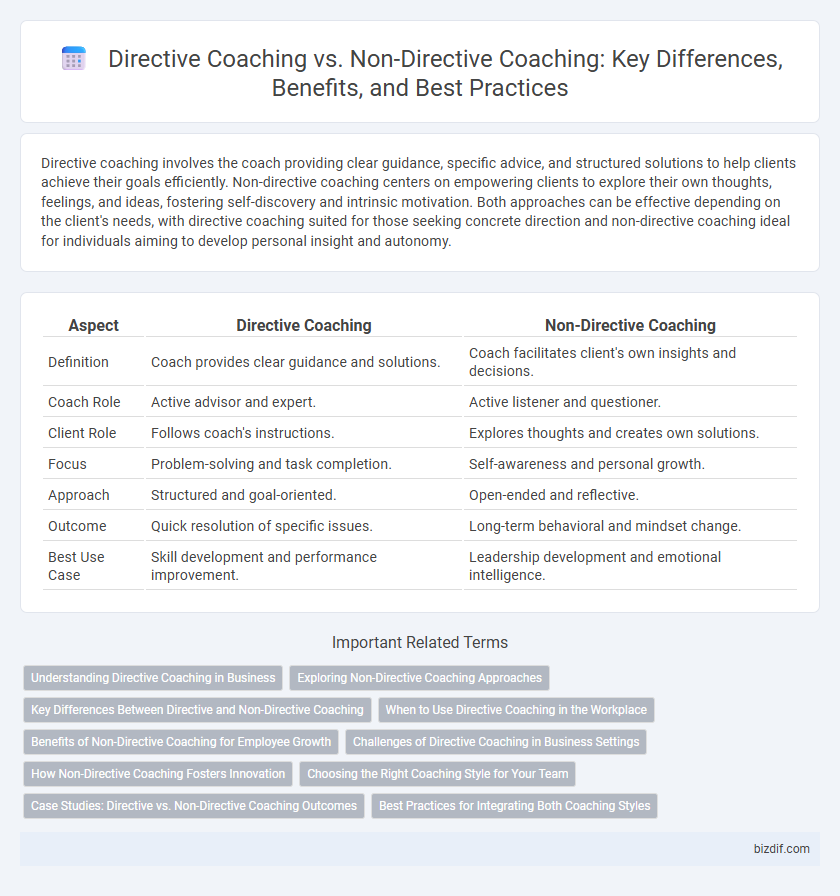Directive coaching involves the coach providing clear guidance, specific advice, and structured solutions to help clients achieve their goals efficiently. Non-directive coaching centers on empowering clients to explore their own thoughts, feelings, and ideas, fostering self-discovery and intrinsic motivation. Both approaches can be effective depending on the client's needs, with directive coaching suited for those seeking concrete direction and non-directive coaching ideal for individuals aiming to develop personal insight and autonomy.
Table of Comparison
| Aspect | Directive Coaching | Non-Directive Coaching |
|---|---|---|
| Definition | Coach provides clear guidance and solutions. | Coach facilitates client's own insights and decisions. |
| Coach Role | Active advisor and expert. | Active listener and questioner. |
| Client Role | Follows coach's instructions. | Explores thoughts and creates own solutions. |
| Focus | Problem-solving and task completion. | Self-awareness and personal growth. |
| Approach | Structured and goal-oriented. | Open-ended and reflective. |
| Outcome | Quick resolution of specific issues. | Long-term behavioral and mindset change. |
| Best Use Case | Skill development and performance improvement. | Leadership development and emotional intelligence. |
Understanding Directive Coaching in Business
Directive coaching in business emphasizes clear guidance, structured feedback, and specific instructions to enhance employee performance and achieve organizational goals efficiently. This coaching style involves the coach actively directing the learning process, setting agendas, and providing solutions, which suits environments requiring quick decision-making and compliance. Understanding directive coaching enables leaders to implement targeted interventions that address skill gaps while maintaining control over outcomes.
Exploring Non-Directive Coaching Approaches
Non-directive coaching emphasizes active listening, powerful questioning, and creating a safe space for clients to explore their thoughts and solutions independently. This approach fosters self-awareness and intrinsic motivation, enabling clients to develop personalized strategies aligned with their values and goals. Techniques such as open-ended questions and reflective dialogue empower clients to unlock deeper insights and sustainable behavioral change.
Key Differences Between Directive and Non-Directive Coaching
Directive coaching centers on providing specific guidance, structured feedback, and clear solutions to help clients achieve defined objectives efficiently. Non-directive coaching emphasizes facilitating clients' self-discovery, encouraging open-ended questions, and supporting autonomous decision-making processes. The key differences lie in the coach's role as an expert guiding action versus a partner fostering reflection and personal insight.
When to Use Directive Coaching in the Workplace
Directive coaching is most effective in situations requiring quick decision-making, clear guidance, and skill development within structured tasks or compliance-driven roles. It suits new employees or teams facing tight deadlines and complex problem-solving where specific expertise is needed. Managers often apply directive coaching to ensure alignment with organizational goals and to enhance performance in high-pressure environments.
Benefits of Non-Directive Coaching for Employee Growth
Non-Directive Coaching fosters employee autonomy and enhances critical thinking by encouraging individuals to explore solutions independently. This approach boosts self-confidence, leading to sustained personal and professional growth. Empowering employees through non-directive methods improves decision-making skills and cultivates a proactive workplace culture.
Challenges of Directive Coaching in Business Settings
Directive coaching in business settings often faces challenges such as reduced employee autonomy and limited creative problem-solving, which can hinder innovation. The authoritative nature of directive coaching may lead to resistance or disengagement from employees who prefer collaborative environments. Furthermore, this approach risks overlooking individual employee needs by imposing standardized solutions rather than fostering personalized growth.
How Non-Directive Coaching Fosters Innovation
Non-Directive Coaching fosters innovation by empowering clients to explore ideas freely, encouraging creative problem-solving without limitations. This coaching approach prioritizes active listening and open-ended questioning, enabling individuals to discover unique solutions that align with their intrinsic motivation. By creating a safe space for experimentation, Non-Directive Coaching cultivates an environment where innovative thinking thrives.
Choosing the Right Coaching Style for Your Team
Choosing the right coaching style for your team depends on the team's maturity, goals, and the complexity of tasks. Directive coaching works best when clear guidance and specific instructions are needed to enhance performance quickly, especially with less experienced team members. Non-directive coaching fosters autonomy and critical thinking by encouraging open dialogue and self-discovery, ideal for developing leadership skills and long-term growth.
Case Studies: Directive vs. Non-Directive Coaching Outcomes
Case studies comparing directive and non-directive coaching reveal distinct outcomes in client performance and satisfaction. Directive coaching often leads to quicker skill acquisition and clear goal achievement by providing structured guidance, while non-directive coaching fosters deeper self-awareness and long-term behavioral change through open-ended questioning. Organizations report higher immediate productivity gains with directive methods, whereas non-directive approaches yield sustained engagement and enhanced problem-solving capabilities over time.
Best Practices for Integrating Both Coaching Styles
Blending directive and non-directive coaching styles enhances client outcomes by balancing guidance with autonomy, promoting tailored goal achievement. Best practices include assessing the coachee's readiness and preferences, applying directive techniques for skill-building or problem-solving, and shifting to non-directive methods to foster self-discovery and empowerment. Coaches should maintain flexibility, continuously evaluate progress, and adjust their approach to ensure optimal engagement and sustainable development.
Directive Coaching vs Non-Directive Coaching Infographic

 bizdif.com
bizdif.com